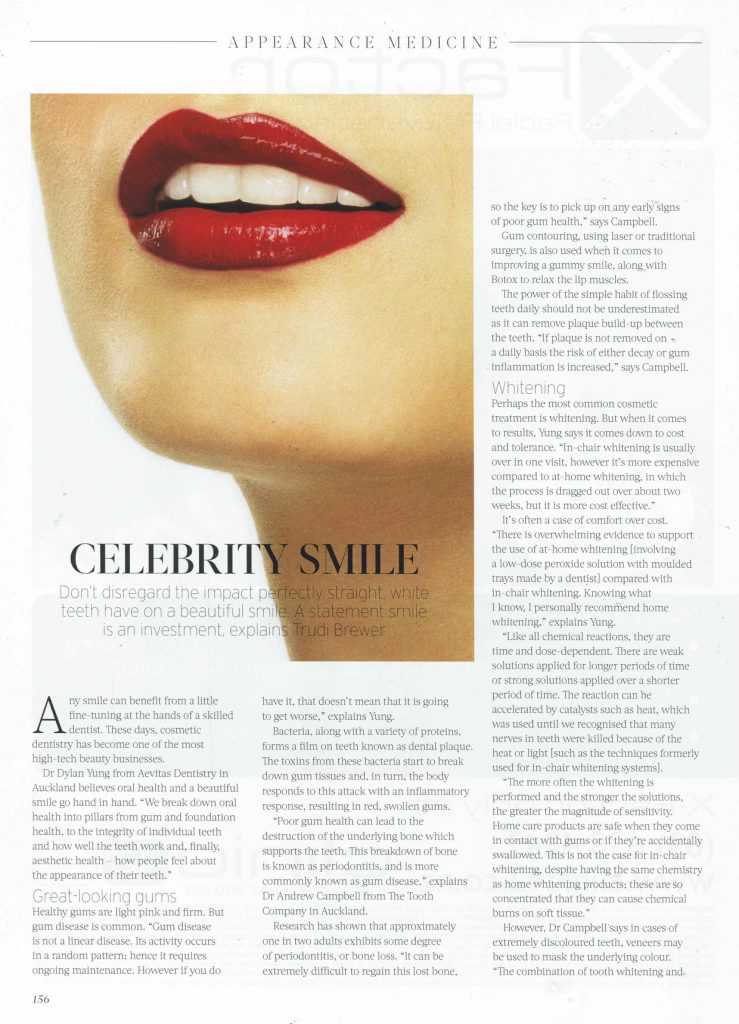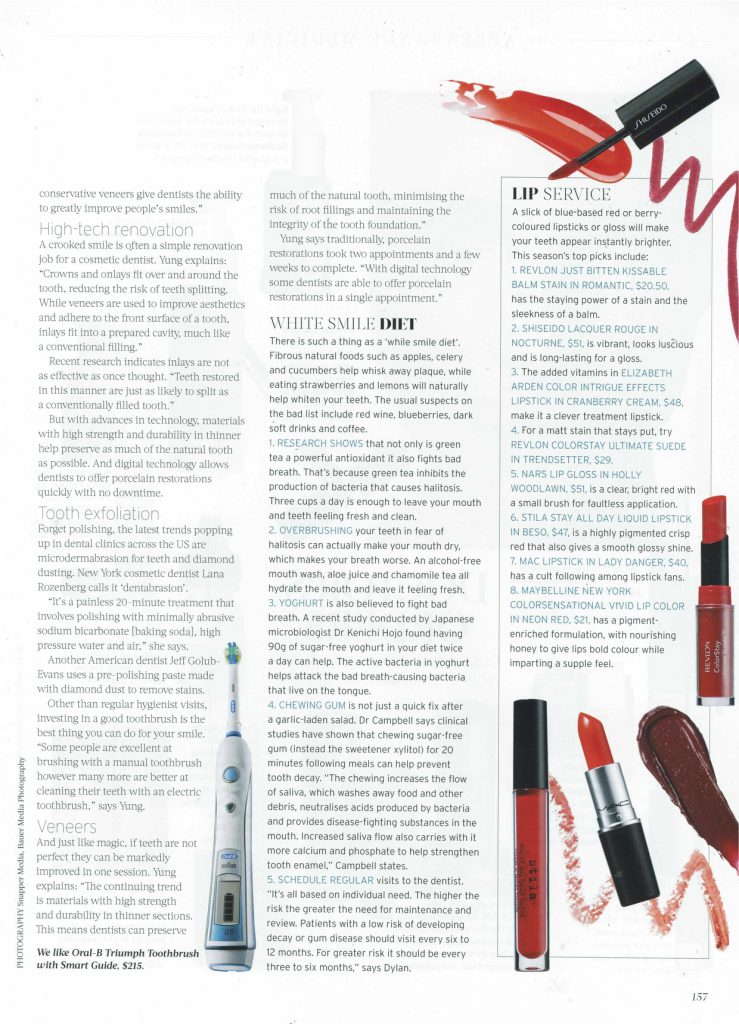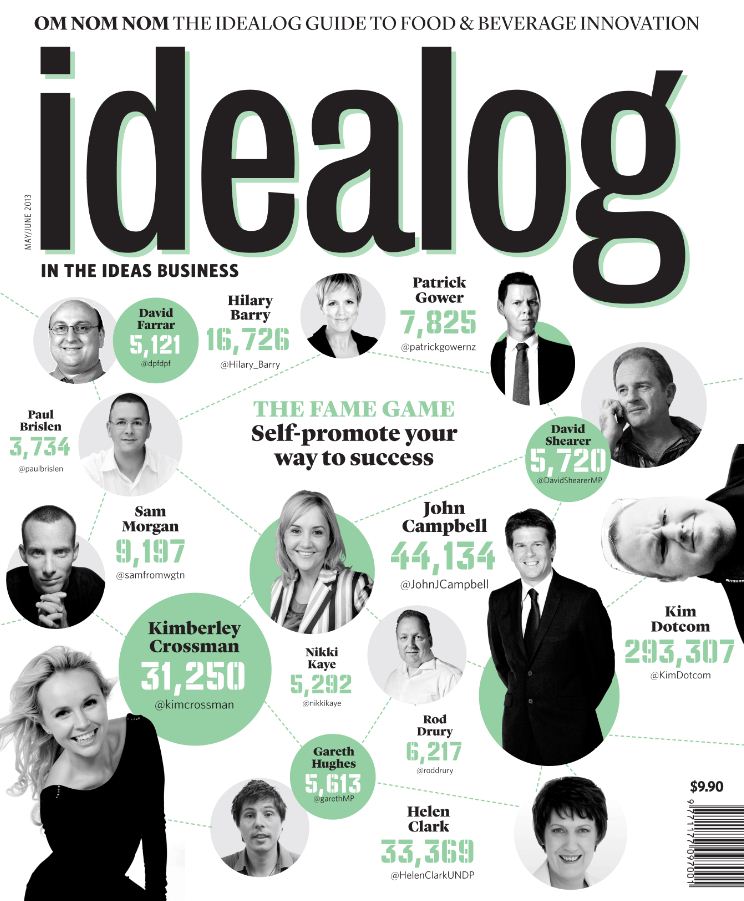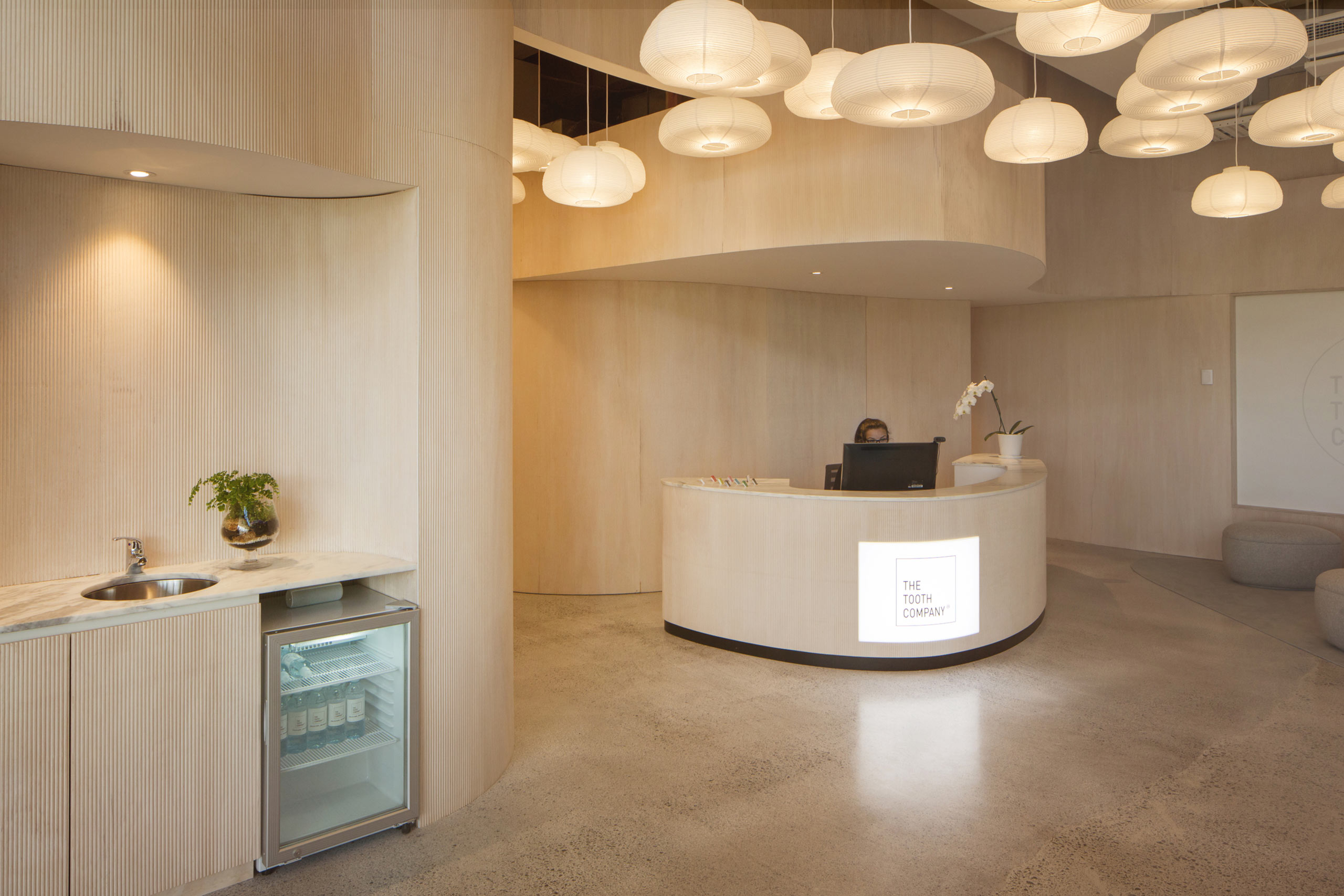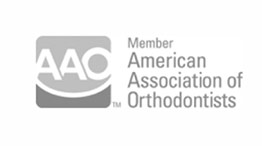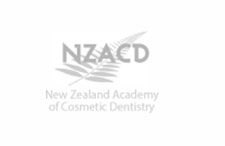Celebrity Smile
Don’t disregard the impact perfectly straight, white teeth have on a beautiful smile. A statement smile is an investment, explains Trudi Brewer.
Any smile can benefit from a little fine-tuning at the hands of a skilled dentist. These days, cosmetic dentistry has become one of the most high-tech beauty businesses.
Dr Dylan Yung from Aevitas Dentistry in Auckland believes oral health and a beautiful smile go hand in hand. “We break down oral health into pillars from gum and foundation health to the integrity of individual teeth and how well the teeth work and, finally, aesthetic health – how people feel about
the appearance of their teeth.”
GREAT LOOKING GUMS
Healthy gums are light pink and firm. But gum disease is common. “Gum disease
is not a linear disease. Its activity occurs in a random pattern; hence it requires ongoing maintenance. However if you do have it, that doesn’t mean that it is going to get worse,” explains Yung.
Bacteria, along with a variety of proteins, form a film on teeth known as dental plaque. The toxins from these bacteria start to break down gum tissues and, in turn, the body responds to this attack with an inflammatory response, resulting in red, swollen gums.
“Poor gum health can lead to the destruction of the underlying bone which supports the teeth . This breakdown of bone is known as periodontitis, and is more commonly known as gum disease” explains Dr Andrew Campbell from The Tooth Company in Auckland.
Research has shown that approximately one in two adults exhibit some degree
of periodontitis, or bone loss. “lt can be extremely difficult to regain this lost bone, so the key is to pick up on any early signs of poor gum health,” says Campbell.
Gum contouring, using laser or traditional surgery, is also used when it comes to
improving a gummy smile, along with Botox to relax the lip muscles . The power of the simple habit of flossing teeth daily should not be underestimated as it can remove plaque build -up between the teeth . “lf plaque is not removed on –
a daily basis the risk of either decay or gum inflammation is increased,” says Campbell.
WHITENING
Perhaps the most common cosmetic treatment is whitening. But when it comes to results, Yung says it comes down to cost and tolerance. “In-chair whitening is usually over in one visit, however it’s more expensive compared to at-home whitening, in which the process is dragged out over about two weeks, but it is more cost effective.”
It’s often a case of comfort over cost. “There is overwhelming evidence to support the use of at-home whitening (involving a low-dose peroxide solution with moulded trays made by a dentist) compared with in-chair whitening. Knowing what I know, I personally recommend home whitening,” explains Yung.
“Like all chemical reactions, they are time and dose-dependent. There are weak solutions applied for longer periods of time or strong solutions applied over a shorter period of time. The reaction can be accelerated by catalysts such as heat, which was used until we recognised that many nerves in teeth were killed because of the heat or light (such as the techniques formerly used for in -chair whitening systems).”
“The more often the whitening is performed and the stronger the solutions, the greater the magnitude of sensitivity. Home care products are safe when they come in contact with gums or if they’re accidentally swallowed. This is not the case for in -chair whitening, despite having the same chemistry as home whiten i ng products; these are so concentrated that they can cause chemical burns on soft tissue.”
However, Dr Campbell’ says in cases of extremely discoloured teeth, veneers may be used to mask the underlying colour.
“The combination of tooth whitening and conservative veneers give dentists the ability to greatly improve people’s smiles.”
HI-TECH RENOVATION
A crooked smile is often a simple renovation job for a cosmetic dentist. Yung explains: “Crowns and onlays fit over and around the tooth, reducing the risk of teeth splitting. While veneers are used to improve aesthetics and adhere to the front surface of a tooth, inlays fit into a prepared cavity, much like a conventional filling.”
Recent research indicates inlays are not as effective as once thought. “Teeth restored in this manner are just as likely to split asa conventionally filled tooth.”
But with advances in technology, materials with high strength and durability are thinner, to help preserve as much of the natural tooth as possible. And digital technology allows dentists to offer porcelain restorations quickly with no downtime.
TOOTH EXFOLIATION
Forget polishing, the latest trends popping up in dental clinics across the US are microdermabrasion for teeth and diamond dusting. New York cosmetic dentist Lana Rozenberg calls it ‘dentabrasion’.
“It’s a pain less 20-minute treatment that involves polishing with minimally abrasive sodium bicarbonate [baking soda], high pressure water and air, ” she says.
Another American dentist Jeff Golub- Evans uses a pre-polishing paste made with diamond dust to remove stains.
Other than regular hygienist visits, investing in a good toothbrush is still the best thing you can do for your smile.
“Some people are excellent at brushing with a manual toothbrush, however many more are better at cleaning their teeth with an electric toothbrush” says Yung.
VENEERS
And just like magic, if teeth are not perfect they can be markedly improved in one session. Yung explains: “ The continuing trend is materials with high strength and durability in thinner sections.
This means dentists can preserve much of the natural tooth, minimising the risk of root fillings and maintaining the integrity of the tooth foundation.”
Yung says traditionally, porcelain restorations took two appointments and a few weeks to complete. “With digital technology some dentists are able to offer porcelain restorations in a single appointment.”
WHITE SMILE DIET
There is such a thing as a ‘while smile diet’. Fibrous natural foods such as apples, celery and cucumbers help whisk away plaque, while eating strawberries and lemons will naturally help whiten your teeth. The usual suspects on the bad list include red wine, blueberries, dark soft drinks and coffee.
- RESEARCH SHOWS that not only is green tea a powerful antioxidant it also fights bad breath. That’s because green tea inhibits the production of bacteria that causes halitosis. Three cups a day is enough to leave your mouth and teeth feeling fresh and clean.
- OVER BRUSHING your teeth in fear of halitosis can actually make your mouth dry, which makes your breath worse. An alcohol-free mouthwash, aloe juice and chamomile tea all hydrate the mouth and leave it feeling fresh.
- YOGHURT is also believed to fight bad breath. A recent study conducted by Japanese microbiologist Dr Kenichi Hojo found having 90g of sugar-free yoghurt in your diet twice a day can help. The active bacteria in yoghurt helps attack the bad breath-causing bacteria that live on the tongue.
- CHEWING GUM is not just a quick fix after a garlic-laden salad. Dr Campbell says clinical studies have shown that chewing sugar-free gum (instead the sweetener xylitol) for 20 minutes following meals can help prevent tooth decay. “The chewing increases the flow of saliva, which washes away food and other debris, neutralises acids produced by bacteria and provides disease-fighting substances in the mouth. Increased saliva flow also carries with it more calcium and phosphate to help strengthen tooth enamel,” Campbell states.
- SCHEDULE REGULAR visits to the dentist.
“It’s all based on individual need. The higher the risk the greater the need for maintenance and review. Patients with a low risk of developing decay or gum disease should visit every six to 12 months. For greater risk it should be every
three to six months,” says Dylan.
